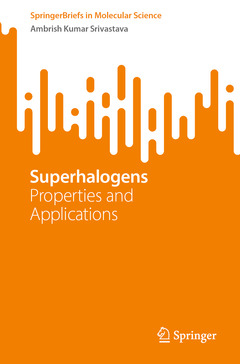Description
Superhalogens, 1st ed. 2023
Properties and Applications
SpringerBriefs in Molecular Science Series
Author: Srivastava Ambrish Kumar
Language: English
Subject for Superhalogens:
Approximative price 47.46 €
In Print (Delivery period: 15 days).
Add to cart71 p. · 15.5x23.5 cm · Paperback
Description
/li>Contents
/li>Biography
/li>Comment
/li>
1 Introduction
1.1. Background
1.2. Theoretical prediction of superhalogens
1.3. Adiabatic electron affinity versus vertical detachment energy
1.4. Experimental confirmation of superhalogens
1.5. Quest for new ligands
1.6. Towards maximization of VDEs
1.7. Electron counting rules
1.8. Non-coordinating anions
1.9. SummaryReferences
2 Transition metal fluorides and oxides as superhalogens
2.1. Introduction
2.2. Transition metal with fluorine ligands
2.3. Transition metal with oxygen ligands
2.4. Transition metal with other ligands
2.5. Summary
References
3 Superhalogens as strong oxidizers
3.1. Introduction
3.2. Oxidation of water and its clusters
3.3. Oxidation of benzene
3.4. Oxidation of fullerene3.5. Oxidation of carbon dioxide
3.6. Oxidation of transition metal oxides
3.7. Oxidation of heterocycles3.8. Oxidation of nitric oxide
3.9. Formation of noble gas compounds
3.10. SummaryReferences
4 Superhalogens in the design of superacids
4.1. Introduction
4.2. Acidity of HAlnF3n+1 species
4.3. Protonated superhalogens as superacids4.4. Origin of (super)acidity
4.5. Path for stronger superacids
4.6. Other superhalogen based superacids4.7. Summary
References
5 Superhalogens in the design of electrolytic salts
5.1. Introduction
5.2. Anions in typical electrolytic salts5.3. New electrolytic salts based on halogen-free superhalogens
5.4. New electrolytic salts based on superhalogen dianions
5.5. SummaryReferences
6 Miscellaneous applications of superhalogens
6.1. Introduction
6.2. Organic superconductors
6.3. Ionic liquids6.4. Liquid crystals
6.5. Nonlinear optical materials
6.6. SummaryReferences
7 Conclusion and future perspectives
Overviews the history and experimental confirmation of superhalogens
Discusses their use in the design of superacids and ionic liquids
Presents basics and latest developments




